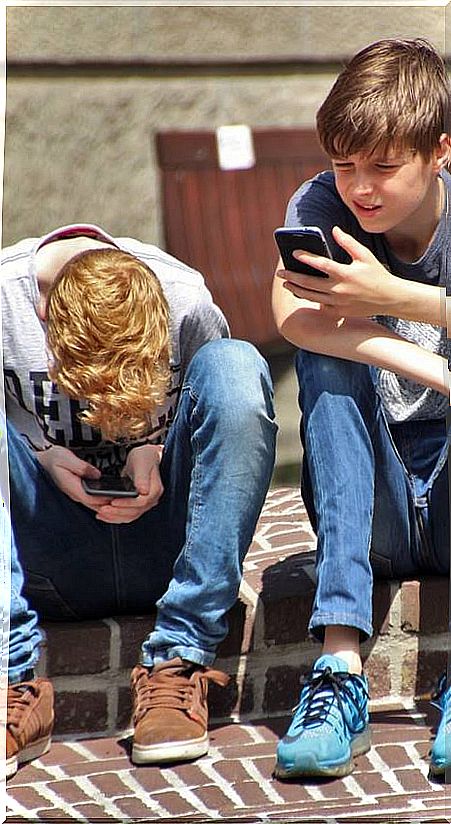New Social Diseases “spread” Through The Networks
The powerful influence that social networks exert on certain young people has led to the consideration of a new category of “socially induced diseases” through platforms of online broadcast. It is a new and very curious phenomenon that experts are already analyzing.

Recently in countries as diverse as Germany, the United Kingdom, Canada, Denmark and France, numerous young people say they are suffering from a modern form of “Gilles de la Tourette Syndrome”, a full-blown “tic disorder” included in the Manual. Diagnosis and Statistics of DSM-V mental illnesses that appear in most cases before the age of 14, and that have specific symptoms:
- The presence of multiple motor tics and one or more verbal tics. The most typical motor tics usually affect the head area, such as blinking, but can also appear in other parts of the body such as the trunk and upper extremities.
- Its evolution is usually of long duration, although it can also occur with periods of complete remission and in certain people it disappears completely at the beginning of their adult life.
The reality about this curious phenomenon is that when these young people were psychologically evaluated they only presented functional symptoms that were reminiscent of this syndrome but did not really suffer from it. What they did suffer, however, was a new “mass social disease” induced through social media.
How this alteration was conceived and “spread” through the networks is surprising. Experts have studied the case and discovered the powerful impact that online media can have on the gestation of new socially induced diseases.
Many young people from different countries thought they suffered from this syndrome and went to medical consultations suffering from this new disorder that caused very specific symptoms:
When evaluating them psychologically, the experts came to the same conclusion: all those young people had functional symptoms of Gilles de la Tourette Syndrome but, in reality, they did not suffer from it. What was happening?
How social illnesses are induced in networks
Experts in the field, such as Dr. Kristen R. Müller -Vahl, professor at the Department of Psychiatry, Socialpsychiatry and Psychotherapy at the Hannover School of Medicine (Germany) argue that we are facing a true “new mass social disease”, induced through the all-powerful online social media and that has caught fire like wildfire favored by the wind of isolation from the pandemic. And, that for this you do not need to know or interact with anyone for its dissemination, it is enough to view the content of these videos to cause a destabilizing effect on the person and think that they suffer from it.
However, it is good to remember that the emotional impact of viewing any online content is mediated by the previous personality characteristics of whoever accesses them. Thus, there will be clearly more influential young people and others less and that also explains, at least to a large extent, why not everyone thinks they have developed this syndrome.
The origin of this new mass disorder: youtube
It seems that the origin of this so-called new “epidemic” began around February 21, 2019, just before the pandemic when a 22-year-old German, Joe Zimmerman, who, judging by the videos, could be considered to be suffering from a mild form of this Syndrome but that began to record and upload videos creating a YouTube channel “Gewitter un Kopt” where he showed what was happening to him.
He assured whoever listened to him that a whole series of movements, vocalizations, phrases, insults and disruptive and strange behaviors that he suffered were actually “tics”. Joe exhibited a whole set of exclamations such as insults and curse words inserted in long sentences. This way of expressing himself was considered by the experts too complex and elaborate for any person who actually suffered from Gilles de la Tourette syndrome to be able to do so.
For example, coprolalia, which is a characteristic symptom of Gilles de la Tourette and where the person suffers from an irresistible impulse to emit obscenities, occurs in a very different way from how Joe showed in his videos. It employed a wide and rich range of changing insults every week and it seems that its content was directly influenced by the number of new views it got by placing its videos among the “most popular”.
What happened after a short time was that the number of subscribers to this YouTube Channel went up like foam. One million followers in less than three months raising Jan Zimmerman as the number one YouTube content creator in Germany in 2019.
That is to say, the secondary gain that Freud would say or the benefit, economic and with a strong social impact, was enormous. 2.91 million teen followers, TopAdwards awards in Germany, and the second highest rated YouTube content creator.
The Associations of people who suffered from this disease strongly protested the distorted presentation and the disrespectful and frivolous treatment of a problem that causes real suffering to many children, adolescents and adults.
But it happened that four weeks after the broadcast of these videos, numerous young people began to come to the consultations of German neurologists saying that they suffered from this Syndrome. Some were even initially diagnosed as such and were being treated with drug treatments as powerful as neuroleptics and even considered as resistant to treatment.
Neither seemed to realize that their symptoms were reminiscent of those in Joe’s videos. And, the funny thing was that when these cases were reviewed, many of their symptoms were similar to those that Joe showed in his videos or they stopped suffering when they practiced their favorite activities and there were even cases in which when they were told that they did not suffer from this Syndrome symptoms vanished as if by magic.
In many cases, they did not become stratospherically famous, like Joe, but they also made secondary gains such as being exempted from certain homework and homework on the grounds that they suffered from this syndrome.
The powerful influence of idols and influencers
What experts such as Bartholomew (2012) believe is that this new modality would fall under the category of “socially induced diseases” but under a new heading “online”, since it meets all the criteria required for this, such as:
- A set of symptoms that suggest the presence of an organic disease with no identifiable cause and that occurs between two or more people who share a set of beliefs about these symptoms.
- The presence of a form of powerful identification that occurs indirectly through the viewing of videos.
- All the patients “admired” Jan Zimmermann for his open way of stating that he suffered from this “so-called Tourette Syndrome” and for achieving success despite his condition as a patient.
The powerful emotions he elicited in his followers were evident. They strongly empathized with him and this was considered to contribute to triggering and spreading infections.
These authors demonstrate the powerful influence of the mass media on the psychology of certain young people, and how the increase in its use due to the isolation to which they were subjected during the COVID-19 pandemic enhanced and made clear their enormous influence on the imitation of certain types of generalized false behaviors and beliefs to the point of coming to consider a new category of “socially induced diseases” through online dissemination platforms.









